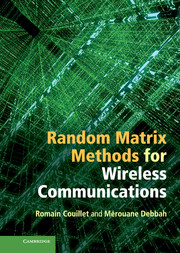Book contents
- Frontmatter
- Contents
- Preface
- Acknowledgments
- Acronyms
- Notation
- 1 Introduction
- Part I Theoretical aspects
- 2 Random matrices
- 3 The Stieltjes transform method
- 4 Free probability theory
- 5 Combinatoric approaches
- 6 Deterministic equivalents
- 7 Spectrum analysis
- 8 Eigen-inference
- 9 Extreme eigenvalues
- 10 Summary and partial conclusions
- Part II Applications to wireless communications
- References
- Index
10 - Summary and partial conclusions
from Part I - Theoretical aspects
Published online by Cambridge University Press: 07 October 2011
- Frontmatter
- Contents
- Preface
- Acknowledgments
- Acronyms
- Notation
- 1 Introduction
- Part I Theoretical aspects
- 2 Random matrices
- 3 The Stieltjes transform method
- 4 Free probability theory
- 5 Combinatoric approaches
- 6 Deterministic equivalents
- 7 Spectrum analysis
- 8 Eigen-inference
- 9 Extreme eigenvalues
- 10 Summary and partial conclusions
- Part II Applications to wireless communications
- References
- Index
Summary
In this first part, we started by introducing random matrices as nothing more than a multi-dimensional random variable characterized by the joint probability distribution of its entries. We then observed that the marginal distribution of the eigenvalues of such matrices often carries a lot of information and may even determine the complete stochastic behavior of the random matrix. For instance, we pointed out that the marginal eigenvalue distribution of the Gram matrix HHH associated with the multiple antenna channel H ∈ ℂN×n is a sufficient statistic for the characterization of the maximum achievable rate. However, we then realized that, for channels H more structured than standard Gaussian i.i.d., it is very difficult to provide a general characterization of the marginal empirical eigenvalue distribution of HHH.
It was then shown that the eigenvalue distribution of certain classes of random matrices converges weakly to a deterministic limiting distribution function, as the matrix dimensions grow to infinity, the convergence being proved in the almost sure sense. These classes of matrices encompass in particular Wigner matrices, sample covariance matrices, models of the type when the e.s.d. of TN and AN have an almost sure limit and Gram matrices where XN has independent entries with a variance profile that has a joint limiting distribution function. The assumptions made on the distribution of the entries of such matrices were in general very mild, while for small dimensional characterization exact results can usually only be derived for matrices with Gaussian independent or loosely correlated entries.
- Type
- Chapter
- Information
- Random Matrix Methods for Wireless Communications , pp. 243 - 248Publisher: Cambridge University PressPrint publication year: 2011



